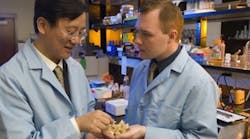Researchers at the University of Wisconsin – Madison, Madison, Wis., have devised a two-step process that converts cellulose into 2,5-dimethyl furan (DMF), a potential fuel. Meanwhile, a team from Virginia Tech, Blacksburg, Va., the University of Georgia, Athens, Ga., and the U.S. Department of Energy’s Oak Ridge National Laboratory, Oak Ridge, Tenn., have developed an enzyme “cocktail” that produces hydrogen from cellulosic materials. At the University of Wisconsin, Ronald Raines, a professor in the departments of chemistry and biochemistry, has developed a mix consisting of solvents and additives that can dissolve cellulose. “This solvent system can dissolve cotton balls, which are pure cellulose,” says Raines. “And it’s a simple system — not corrosive, dangerous, expensive or stinky.” The patent-pending mix uses chemicals small enough to slip between the lignin molecules that surround cellulose. It dissolves the cellulose, creating components that then form 5-hydroxymethylfurfural (HMF). Then, in a second step, the HMF is converted to DMF, a water-immiscible liquid with the energy content of gasoline that already serves as a gasoline additive.

Figure 1 -- Cocktail for chips: Mixture of enzymes
Latest from Environmental Health & Safety
Latest from Environmental Health & Safety
